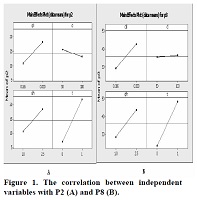Multiple unite sustained released floating of sodium diclofenac: Formulation and evaluation using factorial design
Keywords:
Sodium diclofenac, Floating granules, Gastric residence time, Extruder-spheronizationAbstract
The aim of this study was prepare and evaluate floating granules of sodium diclofenac with lipid excipient for prolonged gastric residence and reduced dose regimen. Floating granules prepared by extruder-spheronization technique. Compritol and gelucire as lipid excipient, HPMC as retardant and tween 80 as emulsifier were used. The effect of drug/lipid, drug/HPMC, drug amount, percentage of tween and type of lipid on floating ability, morphology and dissolution parameters were evaluated by factorial design. Results showed floating ability of granules was influenced by proportion of drug/lipid, drug/HPMC and percentage of tween. Floating property of Compritol was more than gelucire and provided good floating particles. Compritol granules provided suitable sustained release pattern in the manner that increase in D/L reduced D8 and MDT and increase in %T increased MDT. Higuchi model was the best fitted for dissolution data of granules prepared by Compritol and gelucire. In conclusion, Compritol provided more suitable floating ability and sustained release property.
References
Soppima K., et al. Microspheres as floating drug
delivery systems to increase gastric retention of
drugs. Drug Metabol Rev 2001; 33: 149-160.
Whitehead L., et al. Development of gastero
retentive dosage form. Eur J Pharm 1996; 4: 61-
Patel DM., Patel NM., Patel VF., Bhatt DA.
Floating granules of ranitidine hydrocholoridegelucire 43/01: formulation optimization using
factorial design. AAPS PharmSciTech 2007; 8:
E1-E7.
Moes A.J. Gastro retentive dosage forms. Critical
Review in Therapeutic Drug Carrier Systems
; 10: 143- 195.
Singh B., et al. Floating drug delivery systems: an
approach to oral controlled drug delivery via
gastric retention. J Control Rel 2000; 63: 235-259.
Barthelemy P., Laforet J.P., Farah N., Jochim J.,
Compritol ATO 888: an innovative hot-melt
coating agent for prolonged release drug
formations. Eur J Pharm Biopharm 1999; 47: 87-
Hamdani J., Moe A.J., Amighi K. Physical and
thermal characterisation of precirol and compritol
as lipophilic glyceride used for the preparation of
controlled release matrix pellets. Int J Pharm
; 260: 47-57.
Chauhan B., Shimpi S., Mahadik K.R., Paradakar
A. Preparation and evaluation of risedronate
sodium gelucire 39/01 matrices. Acta Pharm
; 54: 205-214.
Scholer, D.W., Ku, E.C., Boettcher, I., Schweizer,
A. Pharmacology of diclofenac sodium. Am J
Med. 1986; 80: 34-8.
Schweitzer, A., Hasler-Nguyen, N., Zijlstra J.
Preferential uptake of the non steroid antiinflammatory drug diclofenac into inflamed
tissues after a single oral dose in rats. BMC
Pharmacol. 2009; 9:5.
Gohel, M.C., Amin, A.F.. Formulation
optimization of controlled release diclofenac
sodium microspheres using factorial design. J
Control Release. 1998; 51: 115-22.
Gohel, M.C., Amin, A.F. Formulation design and
optimization of modified-release microspheres of
diclofenac sodium. Drug Dev Ind Pharm. 1999;
: 247-51.
Piyakulawat, P., Praphairaksit, N., Chantarasiri,
N., Muangsin, N. Preparation and evaluation of
chitosan/carrageenan beads for controlled release
of sodium diclofenac. AAPS PharmSciTech.
; 8: E97.
Avachat, A., Kotwal, V. Design and evaluation of
matrix-based controlled release tablets of
diclofenac sodium and chondroitin sulphate.
AAPS PharmSciTech. 2007; 8: E88.
Rahman MA., Ahuja A., Baboota S., et al. Recent
advanced in pelletization technique for oral
drug delivery: A review. Current Drug Del 2009;
: 122-129
Mirghani A., Idkaidek NM., Salem M.S., Najib
N.M. Formulation and release behavior of
diclofenac sodium in Compritol ATO 888 matrix
beads encapsulated in alginate. Drug Dev Ind
Pharm 2000; 26: 791-795
Maswadeh A.H., Al-Hanbali O.A., Kanaan R.A.,
Shakya A.K., Maraqa A. Testing lyoequivalency
for three commercially sustained release tablets
containing diltiazem hydrochloride. Acta Pol
Pharm Drug Res 2010; 1: 93-97
Barakat, N.S., Elbagory I.M., Almurshedi A.S.
controlled-release carbamazepine matrix granules
and tablets comprising lipophilic and hydrophilic
components. Drug Del 2009: 16: 57-65.
Gao p., Skoug J.W., Nixon P.R., Ju T.R., Stemm
N.L., Sung K.C. Swelling of HPMC matrix
tablets. 2. Mechanistic study of the influence of
formulation variables on matrix performance and
drug release. J Pharm Sci 1996; 85: 732-740.
Rekhi G.S., Nellore R.V., Hussain A.S., Tillman
L.G., Malinowski H.J., Augsburger L.L.
Identification of critical formulation and
processing variables for metoprolol tartarate
extended-release matrix tablets. J Control Rel
; 59: 327-342.






